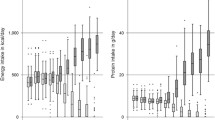Abstract
Serum preprandial essential amino acid, urea and prealbumin concentrations, and growth rates were studied in appropriate for gestational age low birth weight infants fed one of three regimens: (1) human milk enriched with human milk protein (n=17); (2) bovine whey protein hydrolysate (n=18; and (3) a mixture of bovine proteins, peptides and amino acids designed to have an amino acid composition close to that of human milk proteins (n=18). Energy and nitrogen intakes were similar in all groups. Growth rates and gross metabolic responses did not differ between the feeding groups. There were also no differences in the amino acid profiles between those infants fed human milk protein fortifier and mixed bovine protein fortifier. Infants fed the whey fortifier had significantly higher threonine concentrations in comparison to those fed exclusively human milk protein (287±63 μmol/l vs 168±26 μmol/l) whereas the levels of some other essential amino acids (i.e. valine, leucine, lysine, histidine, phenylalanine and tryptophan) were lower. The results indicate that growth rates and gross metabolic indices do not depend on the protein quality of human milk fortifiers. However, the addition of well balanced mixtures of bovine proteins to human milk results in amino acid profiles similar to those observed in LBW infants fed similar amounts of human milk proteins.
Similar content being viewed by others
Abbreviations
- LBW:
-
Iow birth weight
References
American Academy of Pediatrics, Committee on Nutrition. (1985) Nutritional need of low-birth-weight infants. Pediatrics 75:976–986
Bochm G, Senger H, Friedrich M, Müller DM, Beyreiß K (1990) Protein supplementation of human milk for the nutrition of VLBW infants: human milk protein versus meat protein hydrolysate. Klin Pädiatr 202:316–320
Boehm G, Borte M, Müller DM, Senger H, Rademacher Chr (1991) Die Ernährung Frühgeborener mit angereicherter Frauenmilch: EOPROTIN im Vergleich mit Humanalbumin. Kinderärztl Praxis 59:293–298
Cooke RJ, Watson D, Werkman S, Conner C (1992) Effects of type of dietary protein on acid-base balance status, plasma levels of amino acids, and nutrient balance in the very low birth weight infant. J Pediatr 121:444–451
Ehrenkranz RA, Gettner PA, Nelli CM (1989) Nutrient balance studies in premature infants fed formula of fortified preterm human milk. J Pediatr Gastroenerol Nutr 8:58–67
ESPGAN-Committee on nutrition (1987) Feeding the preterm infant. Acta Paediatr Scand [Suppl] 336:2–18
Georgi G, Sawatzki G (1992) Design of optimal protein composition for infant nutrition. In: Koletzko B, Okken A, Rey J, Salle B, VanBiervliet JP (eds) Recent advances in infant feeding. Georg Thieme Stuttgart, New York, pp 148–155
Gropper SS, Gropper DM, Acosta PB (1993) Plasma amino acid response to ingestion of L-amino acids and whole protein. J Pediatr Gastroenterol Nutr 16:143–150
Kashyap S, Okamoto O, Kanya S, Zucker C, Abildskov K, Dell RB, Heird WC (1987) Protein quality in feeding low birth weight infants: a comparison of whey-predominant versus casein-predominant formulas. Pediatrics 1987; 79:748–577
Mondanlou HD, Lim MO, Hansen JW, Sickles V (1986) Growth, biochemical status, and mineral metabolism in very low birth weight infants receiving fortified preterm human milk. J Pediatr Gastroenterol Nutr 5:762–766
Moro G, Minoli I, Fulconis F, Cleminti M, Räihä NCR (1991) Growth and metabolic responses in low-birth-weight infants fed human milk fortified with human milk protein or with bovine milk protein preparation. J Pediatr Gastroenerol Nutr 13:150–154
Polberger SKT, Axelsson IE, Räihä NCR (1990) Amino acid concentrations in plasma and urine in very low birth weight infants fed protein-unenriched or human milk protein-enriched human milk. Pediatrics 86:909–915
Priolisi A, Didato M, Gioeli R, Fazzolari-Nesci A, Räihä NCR (1992) Milk protein quality in low birth weight infants: effects of protein-fortified human milk and formulas with three different whey-to-casein ratios on growth and plasma amino acid profiles. J Pediatr Gastroentero Nutr 14:450–455
Putet C, Rigo J, Salle B, Senterre J (1987) Supplementation of pooled human milk with casein hydrolysate: energy and nitrogen balance weight gain composition in very low birth weight infants. Pediatr Res 21:458–461
Räihä NCR (1989) Milk protein quantity and quality and protein requirements during development. Adv Pediatr 36:347–368
Raschko PK, Hiller JL, Benda GI, Buist NRM, Wilcox K, Raynolds JW (1989) Nutritional balance studies of VLBW infants fed their mother's milk fortified with a liquid human milk fortifier. J Pediatr Gastroenterol Nutr 9:212–218
Renner E (1982) Milch und Milchprodukte in der Ernährung des Menschen. Th Mann Verlag, Gelsenkirchen-Buer
Report of the Joint FAO/WHO ad hoc Expert Committee (1973) In: Energy and protein requirements. FAO Nutritional Series, Food and Agriculture Series of the United Nations. Rome 17:102–117
Rigo J, Senterre J (1987) Significance of plasma amino acid patterns in preterm infants. Biol Neonate [Suppl 1] 52:41–49
Rigo J, Senterre J, Putet G, Salle B (1992) Various human milk fortifiers in low birth weight infants fed pooled human milk. Plasma and urinary amino acid concentrations. In: Koletzko B, Okken A, Rey J, Salle B, VanBiervliet JP (eds) Recent advances in infant feeding. Georg Thieme, Stuttgart, New York, pp 164–170
Rönnholm KAR, Simell O, Siimes MA (1984) Human milk protein and medium-chain triglyceride oil supplementation of human milk: plasma amino acids in very-low-birth-weight infants. Pediatrics 74:792–799
Schanler RJ, Garza G (1987) Plasma amino acid differences in very low birth weight infants fed either human milk or whey-dominant cow milk formula. Pediatr Res 21:301–305
Tönz O, Schubinger G (1985) Feeding of very-low-birthweight infants with breast milk enriched by energy, nitrogen and minerals FM 85. Helv Paediat Acta 40:235–238
Ventura V, Brooke OG (1987) Plasma amino acids in small preterm infants fed on human milk of formula. Arch Dis Child 62:1257–1264
Wharton BA (1992) Food for the brain. Proc R Coll Physicians Edinb 22:336–346
Author information
Authors and Affiliations
Rights and permissions
About this article
Cite this article
Boehm, G., Borte, M., Bellstedt, K. et al. Protein quality of human milk fortifier in low birth weight infants: Effects on growth and plasma amino acid profiles. Eur J Pediatr 152, 1036–1039 (1993). https://doi.org/10.1007/BF01957232
Received:
Accepted:
Issue Date:
DOI: https://doi.org/10.1007/BF01957232




